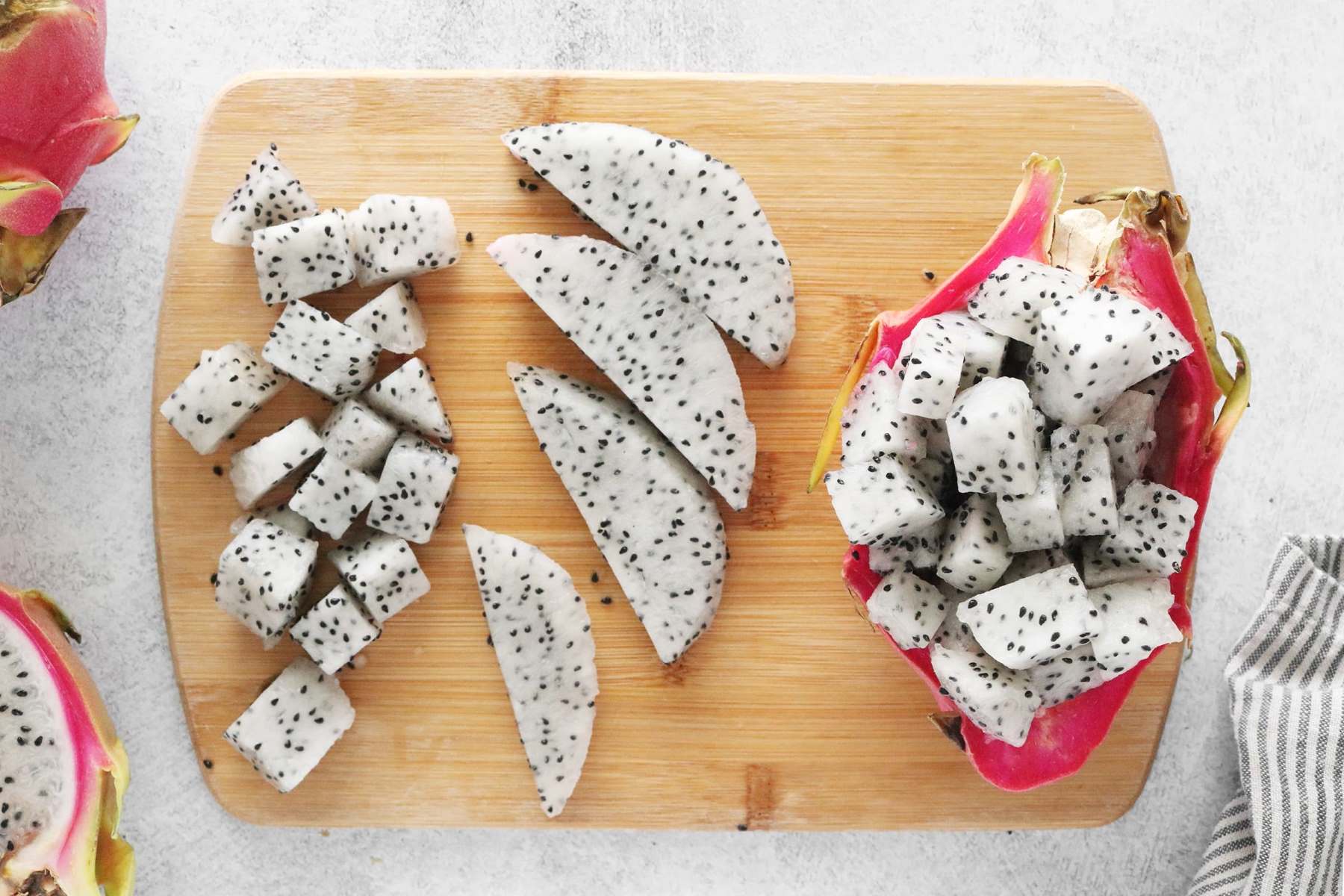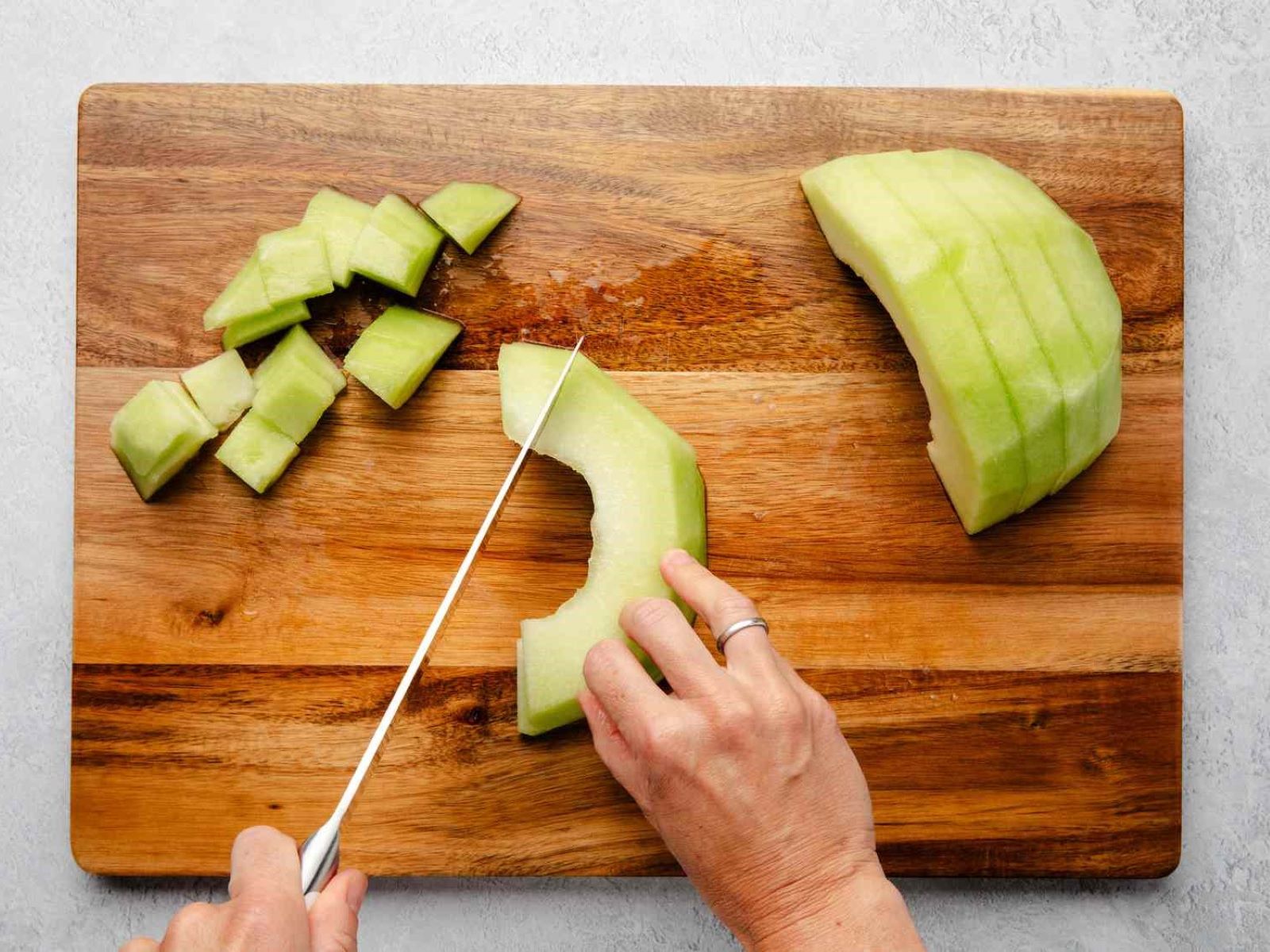Home>Food and Cooking>How To Cut Dragon Fruit


Food and Cooking
How To Cut Dragon Fruit
Published: March 6, 2024
Learn how to cut dragon fruit with ease and precision. Discover expert tips and techniques for preparing this exotic fruit. Perfect for food and cooking enthusiasts!
(Many of the links in this article redirect to a specific reviewed product. Your purchase of these products through affiliate links helps to generate commission for Regretless.com, at no extra cost. Learn more)
Table of Contents
Introduction
Dragon fruit, also known as pitaya, is a visually stunning and exotic fruit that has gained popularity for its unique appearance and refreshing taste. With its vibrant pink or yellow skin and speckled with green scales, the dragon fruit is a tropical delight that captivates the senses. Whether you're a seasoned food enthusiast or a curious culinary explorer, learning how to cut and serve this intriguing fruit can add a touch of adventure to your dining experience.
The process of preparing and cutting a dragon fruit may seem daunting at first, especially if you're unfamiliar with its distinct shape and texture. However, with the right guidance and techniques, you can easily unlock the treasure hidden within its vibrant exterior. From selecting the perfect dragon fruit to mastering the art of slicing and serving, this guide will equip you with the knowledge and skills to elevate your culinary repertoire.
As we embark on this journey to unravel the mysteries of the dragon fruit, you'll discover the nuances of choosing the ripest fruit, the best practices for preparation, and the various cutting techniques that can showcase the fruit's inner beauty. Whether you're preparing a vibrant fruit salad, crafting a visually stunning fruit platter, or simply indulging in a solo culinary adventure, understanding the art of cutting dragon fruit will open up a world of creative possibilities in the kitchen.
So, let's delve into the enchanting realm of dragon fruit and unlock the secrets to mastering its preparation and presentation. By the end of this guide, you'll be equipped with the knowledge and confidence to transform this exotic fruit into a captivating centerpiece for your culinary creations. Get ready to embark on a flavorful journey as we explore the art of cutting and serving dragon fruit with finesse and flair.
Choosing the Right Dragon Fruit
When it comes to selecting the perfect dragon fruit, paying attention to certain visual and tactile cues can make all the difference in ensuring a delightful culinary experience. Here's a comprehensive guide to help you choose the ripest and most flavorful dragon fruit:
Visual Inspection
- Color: Look for dragon fruits with vibrant, evenly colored skin. The most common varieties are either bright pink with green scales or yellow with green scales. Avoid fruits with dull or overly dark skin, as they may indicate overripeness.
- Scales: The scales on the skin should be prominent and evenly distributed. A healthy dragon fruit will have bright green scales that contrast with the underlying skin color.
Texture and Firmness
- Gentle Squeeze Test: Gently press the fruit with your fingertips. A ripe dragon fruit should have a slight give, similar to a ripe avocado. However, it should not feel too soft or mushy, as this could indicate overripeness.
- Firmness: Avoid fruits that are excessively firm, as they may need more time to ripen. The ideal dragon fruit should yield slightly to gentle pressure without feeling too soft.
Aroma
- Fragrance: Take a moment to inhale the aroma near the stem of the dragon fruit. A ripe fruit will emit a subtle, sweet fragrance. If the fruit lacks a distinct aroma, it may not be fully ripe.
Stem Remnants
- Freshness Indicator: Examine the remnants of the stem on the top of the fruit. A green, healthy-looking stem indicates that the fruit was harvested at the right time. Avoid fruits with dried or shriveled stems, as they may have been harvested too early.
By carefully considering these factors, you can confidently select a ripe and flavorful dragon fruit that is ready to be transformed into a delectable culinary creation. Whether you're preparing a refreshing fruit salad, blending a vibrant smoothie, or simply savoring the fruit on its own, choosing the right dragon fruit sets the stage for a delightful gastronomic experience.
Preparing the Dragon Fruit
Before delving into the art of cutting a dragon fruit, it's essential to prepare the fruit properly to ensure a seamless and enjoyable culinary experience. The preparation process involves a few simple yet crucial steps that will enhance the fruit's appeal and make it easier to handle. Here's a detailed guide on how to prepare a dragon fruit for cutting and serving:
Washing the Fruit
Begin by rinsing the dragon fruit under cool running water. Gently scrub the skin with a soft brush or your fingertips to remove any surface impurities or residues. This step is essential for maintaining cleanliness and ensuring that the fruit's exterior is free from any contaminants.
Drying the Fruit
After washing the fruit, pat it dry with a clean kitchen towel or paper towel. Ensuring that the fruit is thoroughly dry will make it easier to handle during the cutting process. Additionally, a dry surface will prevent the fruit from slipping or becoming too slippery, allowing for better control when slicing.
Read more: How To Cut Cabbage
Trimming the Ends
Using a sharp knife, carefully trim off the top and bottom ends of the dragon fruit. This step creates stable, flat surfaces that make it easier to position the fruit for cutting. By removing the ends, you'll also gain access to the flesh inside, setting the stage for the next phase of the preparation process.
Optional: Peeling the Skin
While the skin of the dragon fruit is edible, some prefer to remove it before cutting the fruit. If you choose to peel the fruit, use a sharp knife to make a shallow incision along the length of the fruit, cutting through the skin but not the flesh. Once the incision is made, gently peel away the skin to reveal the luscious, white or vibrant pink flesh inside.
By following these preparatory steps, you'll set the stage for a seamless and enjoyable cutting experience. Whether you opt to leave the skin on for visual appeal or prefer to peel the fruit for a different texture, preparing the dragon fruit with care and attention will elevate the overall culinary experience.
Cutting Techniques
Mastering the art of cutting a dragon fruit is an essential skill that allows you to unleash the captivating beauty and delectable flavor hidden within. With its striking appearance and unique internal structure, the dragon fruit presents an opportunity to showcase your culinary creativity through various cutting techniques. Whether you're aiming for visually stunning presentations or convenient bite-sized pieces, the following cutting methods will empower you to transform the dragon fruit into a work of art on your plate.
1. Slicing into Halves
Begin by placing the prepared dragon fruit on a clean, stable surface. With a sharp knife, carefully slice the fruit vertically, creating two equal halves. The vibrant flesh, speckled with tiny black seeds, will be revealed in all its glory. This method is ideal for showcasing the fruit's intricate interior and can serve as a visually striking centerpiece for fruit platters or dessert presentations.
Read more: How To Draw A Dragon
2. Cross-Hatch Cubes
For a visually appealing and convenient serving option, consider creating cross-hatch cubes from each half of the dragon fruit. After slicing the fruit into halves, make a series of vertical cuts without piercing through the skin, followed by horizontal cuts, creating a grid-like pattern. Once completed, gently push the skin from the back to invert the flesh, revealing perfectly portioned cubes that are ready to be enjoyed as a refreshing snack or added to fruit salads.
3. Scooping Out the Flesh
If you prefer a more refined presentation or intend to use the dragon fruit in smoothies or desserts, scooping out the flesh is an excellent technique. After halving the fruit, use a spoon to carefully separate the flesh from the skin, ensuring that the entire interior is extracted in one piece. This method yields smooth, intact pieces of fruit that can be incorporated into various culinary creations with ease.
4. Creative Shapes and Designs
Unleash your artistic flair by experimenting with creative shapes and designs when cutting dragon fruit. From intricate flower-like patterns to whimsical geometric shapes, the unique texture and color of the fruit provide an excellent canvas for culinary artistry. With the use of cookie cutters or a steady hand, you can transform the dragon fruit into captivating shapes that elevate the visual appeal of your dishes.
5. Wedges for Easy Enjoyment
For a simple and convenient serving option, consider cutting the dragon fruit into wedges. After halving the fruit, proceed to slice each half into triangular wedges, similar to cutting a melon. This method is perfect for casual gatherings, as it allows for easy, handheld enjoyment of the fruit while retaining its natural elegance.
By mastering these cutting techniques, you'll unlock the full potential of the dragon fruit, turning it into a versatile and visually captivating ingredient for a wide range of culinary creations. Whether you're aiming for intricate designs or convenient portions, the art of cutting dragon fruit offers a delightful blend of creativity and practicality, enriching your culinary repertoire with its unique charm and flavor.
Read more: How To Cut A Peach
Serving Suggestions
Transforming freshly cut dragon fruit into enticing culinary creations opens the door to a myriad of serving possibilities. Whether you're hosting a vibrant brunch, preparing a refreshing dessert, or simply indulging in a solo culinary adventure, the versatile nature of dragon fruit lends itself to a wide array of serving options. Here are some imaginative and delectable ways to showcase this exotic fruit:
1. Exotic Fruit Salad
Combine freshly cut dragon fruit with an assortment of tropical fruits such as mango, pineapple, and kiwi to create a colorful and refreshing fruit salad. The vibrant hues and contrasting textures of the fruits will not only tantalize the taste buds but also add a visually stunning element to your table.
2. Dragon Fruit Smoothie Bowl
Blend ripe dragon fruit with creamy coconut milk and frozen bananas to create a luscious and vibrant smoothie bowl. Top it with a medley of fresh berries, granola, and chia seeds for added texture and nutritional benefits. This visually appealing and nutritious creation is perfect for a wholesome breakfast or a post-workout energy boost.
3. Tropical Fruit Skewers
Thread chunks of dragon fruit onto skewers along with other tropical fruits such as papaya, melon, and strawberries. This presentation not only enhances the visual appeal of the fruits but also makes for a convenient and portable serving option, ideal for outdoor gatherings and picnics.
Read more: How To Cut Metal Roofing
4. Dragon Fruit Sorbet
Transform the vibrant flesh of dragon fruit into a refreshing sorbet by blending it with a touch of lime juice and a hint of honey. The resulting sorbet boasts a delightful balance of sweetness and tanginess, making it a delightful palate cleanser or a guilt-free dessert option.
5. Exquisite Fruit Platter
Arrange a selection of freshly cut dragon fruit, alongside an assortment of other seasonal fruits, on a large platter to create a visually striking and inviting centerpiece for gatherings and celebrations. The vibrant colors and enticing aromas will captivate the senses and encourage guests to indulge in a delightful fruit feast.
6. Dragon Fruit Parfait
Layer diced dragon fruit with creamy Greek yogurt, granola, and a drizzle of honey to create a visually appealing and satisfying parfait. This versatile creation can be enjoyed as a wholesome breakfast, a light dessert, or a delightful midday snack.
7. Culinary Garnish
Use creatively cut dragon fruit pieces as a striking garnish for desserts, cocktails, and savory dishes. The vibrant color and unique appearance of the fruit make it an eye-catching addition that elevates the visual appeal of various culinary creations.
By exploring these serving suggestions, you can unleash the full potential of dragon fruit, infusing your culinary repertoire with a touch of tropical elegance and vibrant flavors. Whether you're aiming to impress guests with visually stunning presentations or simply seeking to elevate your everyday dining experience, the art of serving dragon fruit offers a delightful fusion of creativity and gastronomic delight.
Conclusion
In conclusion, mastering the art of cutting and serving dragon fruit opens up a world of culinary creativity and sensory delight. From the moment of selecting the perfect fruit to exploring a myriad of cutting techniques and serving options, the journey of preparing dragon fruit is a captivating blend of visual allure and delectable flavors.
By carefully choosing a ripe and vibrant dragon fruit, you set the stage for a delightful culinary experience. The visual cues of color, scales, texture, and aroma serve as your guide in selecting a fruit that promises a burst of tropical sweetness and refreshing juiciness.
The preparation process, including washing, drying, and optionally peeling the fruit, ensures that the dragon fruit is primed for the cutting phase. These steps not only enhance cleanliness but also make the fruit more manageable and visually appealing.
When it comes to cutting techniques, the versatility of the dragon fruit shines through. Whether you opt for halving, creating cross-hatch cubes, scooping out the flesh, or experimenting with creative shapes, each method offers a unique way to showcase the fruit's inner beauty. The artistry of cutting dragon fruit allows for a seamless integration of visual appeal and practicality, making it a versatile ingredient for a wide range of culinary creations.
Furthermore, the serving suggestions provide a delightful array of options to elevate the dragon fruit into captivating culinary creations. From exotic fruit salads to vibrant smoothie bowls and exquisite fruit platters, the versatility of dragon fruit lends itself to a myriad of serving possibilities, each offering a delightful fusion of flavors and visual allure.
In essence, the journey of cutting and serving dragon fruit transcends the realm of mere culinary preparation. It becomes a celebration of creativity, a feast for the senses, and an invitation to savor the vibrant essence of tropical indulgence. Whether you're crafting a visually stunning dessert, preparing a refreshing snack, or simply adding a touch of elegance to your culinary presentations, the art of cutting and serving dragon fruit offers a delightful fusion of creativity and gastronomic delight.
As you embark on your culinary adventures, may the vibrant allure of dragon fruit continue to inspire your creativity and elevate your dining experiences with its exotic charm and delectable essence.









